Classical Music CDs Round-Up 2 | reviews, news & interviews
Classical Music CDs Round-Up 2
Classical Music CDs Round-Up 2
The Arts Desk on the latest classical CDs
CD of the Month
Schubert: Winterreise, Mark Padmore/Paul Lewis (harmonia mundi)
by Ismene Brown
The fact that there are 271 commercial or “well-known pirate” recordings of Schubert’s Winterreise, according to the the Schubert Institute's discography tells better than anything how personally and directly this song cycle speaks to singers, all wanting to walk into that snow and plant their feet on that grave of tears. What was a young man’s tale has become one equally felt by women - this year’s Building a Library recommendations on Radio 3 prioritised versions by soprano Christine Schäfer and alto Nathalie Stutzmann (and further back Lotte Lehmann and Brigitte Fassbänder left unforgettable recordings). So it’s allcomers welcome, including oratorio and baroque specialists such as the English tenor Mark Padmore, who here stakes his claim on more romantic territory in harness with pianist Paul Lewis.
With such a vast range of approaches and choices, and inevitably influenced by a small number of one’s own firm favourites, one steps gingerly to judgment. But the question is surely universal to everyone: it’s how directly into my deepest emotional centre the singer communicates this icy tragedy to me, a tale almost of self-immolation, of a young man with hot tears on his face outside a girl’s shut door who becomes, through a combination of depression and hallucination, a hypothermic vagrant by the end, having virtually walked himself to death.
What does love have to do with this journey that Schubert wove from Wilhelm Müller’s poems? It’s unclear. Maybe the young man is simply in love with the idea of being in love, since we find out nothing more than that the object of his passion had a mother who was anxious for the girl to marry (1: Gute Nacht), and that she married someone else (2: Die Wetterfahne) - but that they may have kissed once (indicated in the piano part in 7: Auf dem Flusse).
The fact that this sweetheart is so absent from the man’s musings makes it impossible to hear this cycle as a “told” narrative, rather than as a felt experience of the process of dying, hence my lack of attraction to Mark Padmore’s recording. Padmore is an exemplary, golden-toned tenor Evangelist and Handel singer, but he takes a proclamatory approach to words, rather than an imaginative, empathising one. In Winterreise the combination of poetry and music invites a vast spectrum of approach between the strongly enunciated verbal narrative (such as Fischer-Dieskau can, at mesmerising extreme, epitomise) or the intuitive subtext that may sometimes be at odds with the words (where this lies all in the tonal inflection of the voice, and I think of Matthias Goerne and Lehmann, for examples of this).
Padmore’s English vowel-making affects how he delivers and inflects those all-expressive "ei" and "e" sounds, true, yet Peter Pears's worse German accent doesn’t impede his instinct for the expressive loading of a sound. Although I hear how eloquently Padmore’s describing what is happening to him, I don’t shiver at his frozen tears (3: Gefrorne Tränen) or tremble at that lost song where he sees and ignores the signpost back to sanity (20: Der Wegweiser) because this singer has a habit of signposting his words by overemphasising consonants, and always has a full complement of breath to fill out a phrase. Padmore just sounds too sane.
By comparison Peter Schreier, another tenor with a healthy-sounding voice (rather than the vaporous timbre of Pears, say), consummately manages through the total absorption of the psychic undertow to convey the relentless ebbing of strength and reason, and takes you deep into the exhausting whirlwind of romanticism - considerably aided by the nature-loving accompaniment of Sviatoslav Richter.
What justifies this new version is the remarkable accompanying by Paul Lewis, in whose veins a much richer blood seems to circulate. Listen to that transfixing, miasmic playing on 15: Die Krähe, or the profound sense of pain he infuses into 17: Im Dorfe, the song when it’s clear this man has fixed his own path away from all others. Lewis also finds a prescient parallel between the bare fifths of the closing song of the first half, 12: Einsamkeit, and the fifths of the last, 24: Der Leiermann, where he smudges that fifth literally as if "mit starren Fingern". But when there are other recordings where pianist and singer are sharing the poetic experience so unanimously, it seems unsatisfactory to recommend a recording for the pianist, rather than the singer. Buy on Amazon
Other New Releases
Shostakovich: Symphonies Nos. 5 & 9, Royal Liverpool Philharmonic Orchestra/Vasily Petrenko (Naxos)
by Edward Seckerson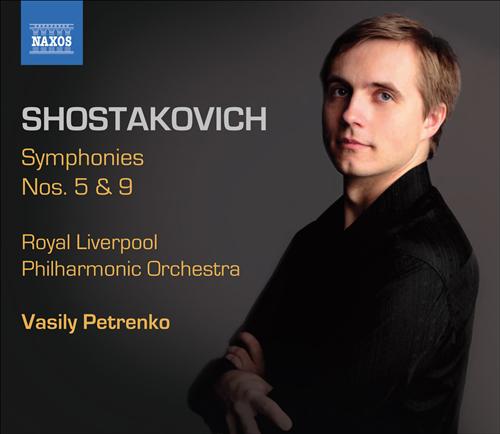 Vasily Petrenko has quickly made the leap from promising to exceptional and this second instalment in his Shostakovich symphonies cycle with a transformed Royal Liverpool Philharmonic brings genuine surprises and near-revelations.
Vasily Petrenko has quickly made the leap from promising to exceptional and this second instalment in his Shostakovich symphonies cycle with a transformed Royal Liverpool Philharmonic brings genuine surprises and near-revelations.
The first thing that strikes one about this performance of the Fifth Symphony is its atmosphere. A wintry light descends with the arrival of the searching first subject: space, mystery, and a sense of collective heartache characterise the long opening paragraph. The reach and control of it are quite simply masterly. I should like to have heard more from the gravelly low horns as warring forces move in for the development, but its ugly goose-step is suitably intimidating with shrill, coruscating woodwinds and a screwing of tension towards the defiant “filmic” release spectacularly underpinned with pedal points in the trombones.
The really big advance in the RLPO’s playing under Petrenko has been in the strings and the work he has done towards achieving a deep and intense sostenuto shines through in the great Largo. There’s a lovely free-flowing shape to it and yet, in the wonderful Tallis-like moments at its heart, a stillness. I don’t think I’ve ever heard such an immense crescendo on the climactic tremolando.
And that sense of overreach, of daring, is carried through into the contentious finale, where Petrenko elects to give us the coded “hollow victory” approach to the coda. Not even Rostropovich went quite so far in conveying the dead weight of unearned triumph. From an extremely slow, lugubrious start to the crushing bass drum and timpani pay-off it is beyond implacable. Far from rejoicing, the repeated As torment us.
There’s an equally unsettling subtext to the Ninth Symphony. We know that Shostakovich sketched a rather different start for what was to be the conclusion of his so-called “war trilogy” but that for obvious reasons his celebration of Soviet triumph over the Nazis jack-knifed into officialdom-baiting irony. Petrenko really brings on the grim-faced clowns here. Mordant humour rules, the RLPO woodwinds get to do tasteless stand-up. Even the wistful second-movement intermezzo sounds like so much day-dreaming.
And Petrenko really makes capital of the “interrupted” Largo, where one desolate bassoon completely wrong-foots us, switching from lament to beery jocularity in a heartbeat. The “Red Army Band” offer a vulgar salute that Petrenko then turns into a reckless and irreverent gallop. Terrific stuff – and vividly recorded, too. The next instalment can’t come soon enough. Buy on Amazon
Berlioz: Symphonie fantastique, All-Union Radio & TV Orchestra/Gennady Rozhdestvensky (Melodiya)
by Graham Rickson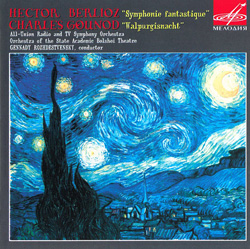 Ripe and wobbly brass, and an artificially spotlit recording balance are not an issue in this Symphonie fantastique – what strikes one is how close the orchestral sonorities on this 1967 Soviet recording are to those on classic French accounts under such conductors as Beecham and Markevich. What you lose in refinement is more than compensated by the sheer excitement of it all; Berlioz, like Mahler, is a composer who benefits from an injection of well-controlled vulgarity.
Ripe and wobbly brass, and an artificially spotlit recording balance are not an issue in this Symphonie fantastique – what strikes one is how close the orchestral sonorities on this 1967 Soviet recording are to those on classic French accounts under such conductors as Beecham and Markevich. What you lose in refinement is more than compensated by the sheer excitement of it all; Berlioz, like Mahler, is a composer who benefits from an injection of well-controlled vulgarity.
The thirtysomething Rozhdestvensky can be thrilling – his control in the central slow movement is mesmerising, and the lower brass muscle in to delirious, resonant effect in the March to the Scaffold. This is a pungent and memorable reading, superbly played by the splendidly named All-Union Radio and TV Symphony Orchestra. The coupling is a similarly full-blooded performance of the “Walpurgisnacht” ballet from Gounod’s Faust with the Bolshoi Theatre Orchestra. Highly recommended. Buy on Amazon
Koechlin: Les Bandar-log, Offrande musicale sur le nom de BACH, SWR Sinfonieorchester Stuttgart/Heinz Holliger (Hänssler Classic)
by Graham Rickson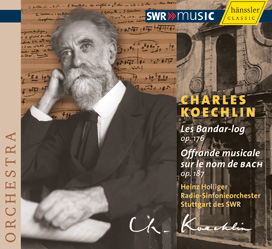 One of those fascinating, shady figures hovering on the fringes of 20th-century music, Charles Koechlin (1867–1950) is best-known for his set of pieces inspired by Kipling’s The Jungle Book and for his Traité de l’orchestration, which was recently praised by Sir Peter Maxwell Davies in a BBC Radio 3 interview. Les Bandar-log, completed in 1940 but with sketches dating back to 1899, is a magnificent achievement. The diaphanous textures that frame the piece are breathtaking and, as the music unfolds, one is continually astonished by Koechlin’s boldness, originality and orchestral technique. Serialism and neo-Classicism are mocked in this depiction of Kipling’s monkeys, who “believe themselves to be creative geniuses, but in reality are vulgar mimics whose sole aim is to follow the fashions of the day”. Reassuringly, Koechlin’s own style can be uncompromising and forward-looking, and there are moments in the work that sound bracingly modern.
One of those fascinating, shady figures hovering on the fringes of 20th-century music, Charles Koechlin (1867–1950) is best-known for his set of pieces inspired by Kipling’s The Jungle Book and for his Traité de l’orchestration, which was recently praised by Sir Peter Maxwell Davies in a BBC Radio 3 interview. Les Bandar-log, completed in 1940 but with sketches dating back to 1899, is a magnificent achievement. The diaphanous textures that frame the piece are breathtaking and, as the music unfolds, one is continually astonished by Koechlin’s boldness, originality and orchestral technique. Serialism and neo-Classicism are mocked in this depiction of Kipling’s monkeys, who “believe themselves to be creative geniuses, but in reality are vulgar mimics whose sole aim is to follow the fashions of the day”. Reassuringly, Koechlin’s own style can be uncompromising and forward-looking, and there are moments in the work that sound bracingly modern.
The Offrande musicale sur le nom de BACH dates from the final years of Koechlin’s life and was first performed in 1973. Twelve movements, all based on the notes B-A-C-H (B flat, A, C, B natural in German notation), are scored for elaborate forces – saxophones, organ, ondes martenot are part of a sparingly used 106-piece orchestra. The quieter, more intimate moments impress most: the seventh section, for solo piano, offers a moment of respite amongst the various canons, fugues and chorales, all harmonised and scored to imaginative effect. The final apotheosis is staggering: high strings sounding out B-A-C-H at top speed over brassy chorales before an ecstatic closing chord. The detailed booklet notes are fascinating, the text interspersed with examples of the composer’s own photography. These are superbly accomplished live performances, lovingly conducted by Koechlin aficionado Heinz Holliger in excellent recorded sound. One of my favourite CDs of the year. Buy on Amazon
Mahler: Symphony No.5, Gürzenich-Orchester Köln/Markus Stenz (Oehms Classics)
by Graham Rickson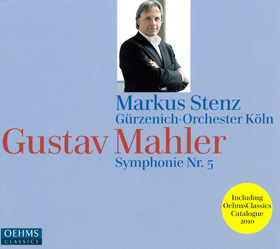 After Tilson Thomas, Zinman and Gergiev comes yet another SACD Mahler cycle, this time from Markus Stenz and the Gürzenich-Orchester Köln. Mahler’s Fifth Symphony was premiered by this orchestra in October 1904, in the same hall where this recording was made. Stenz is chiefly known in the UK for his work with the London Sinfonietta, and this led me to expect a chilly and objective reading. Happily, this is not the case. Stenz says in the booklet notes that he is intensely curious about Mahler – after all, this is a peculiar, bi-polar work that begins with a bleak, dramatic outpouring of grief and finishes 70 minutes later in a mood of ebullient optimism.
After Tilson Thomas, Zinman and Gergiev comes yet another SACD Mahler cycle, this time from Markus Stenz and the Gürzenich-Orchester Köln. Mahler’s Fifth Symphony was premiered by this orchestra in October 1904, in the same hall where this recording was made. Stenz is chiefly known in the UK for his work with the London Sinfonietta, and this led me to expect a chilly and objective reading. Happily, this is not the case. Stenz says in the booklet notes that he is intensely curious about Mahler – after all, this is a peculiar, bi-polar work that begins with a bleak, dramatic outpouring of grief and finishes 70 minutes later in a mood of ebullient optimism.
I especially liked Stenz’s pacing of the final two movements: the Adagietto flows swiftly like the love song Mahler always insisted it was, and the Rondo-Finale is not driven too fast, retaining the music’s humour and wonder rather than turning it into an empty orchestral showpiece. The Cologne orchestra make a superb, rich sound: you notice the darker timbre of the rotary-valved trumpets, and those sustained brass chords in the opening movement are sonorous and weighty. My favourite Mahler Fives are those by Bernstein and Barbirolli – two indulgent readings that at times teeter on the brink of orchestral chaos – but Stenz’s is an excellently recorded modern alternative. Buy on Amazon
Schmidt: Symphony No.2, Fuga Solemnis, Malmö Symphony Orchestra/Vassily Sinaisky (Naxos)
by Graham Rickson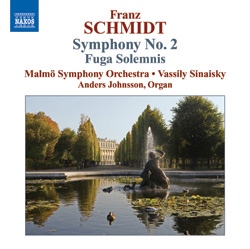 I first encountered the music of Viennese composer Franz Schmidt (1874–1939) via Zubin Mehta’s Decca recording of his sublime and elegiac Fourth Symphony, composed in the 1930s. Schmidt’s Second was completed in 1913. It is unmistakably a product of its time and place: there are frequent strong echoes of Mahler, Bruckner, Strauss and even Elgar. Schmidt uses an enormous orchestra, and the frequent huge climaxes can be wearing – the finale’s closing climax is as exhausting to listen to as it must have been for Sinaisky’s valiant Malmö brass players to play.
I first encountered the music of Viennese composer Franz Schmidt (1874–1939) via Zubin Mehta’s Decca recording of his sublime and elegiac Fourth Symphony, composed in the 1930s. Schmidt’s Second was completed in 1913. It is unmistakably a product of its time and place: there are frequent strong echoes of Mahler, Bruckner, Strauss and even Elgar. Schmidt uses an enormous orchestra, and the frequent huge climaxes can be wearing – the finale’s closing climax is as exhausting to listen to as it must have been for Sinaisky’s valiant Malmö brass players to play.
There are fantastic things in this symphony, but one listens in vain for touches of lightness, wit and humour – elements that Schmidt’s better-known forebears knew how to apply. Personally I felt as if I had eaten a huge box of expensive chocolates in one go, and I needed a quiet sit down and a Bach prelude as purgatives. Still, at budget price, this disc is well worth £4.89 – the recording and playing are opulent and assured. The coupling, the Fuga Solemnis, is a striking and austere late work scored for organ, wind and percussion. Newcomers to Schmidt’s heady world are advised to investigate the Fourth Symphony first. Buy on Amazon
Colbran, the Muse (Rossini Arias), Joyce DiDonato, Santa Cecilia Orchestra & Chorus/Edoardo Müller (Virgin Classics)
by Mark Pappenheim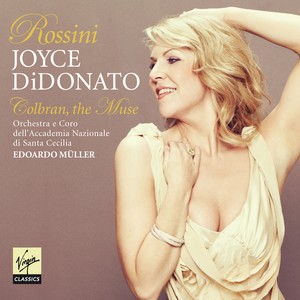 According to the history books, Isabella Colbran, the reigning Spanish diva who ditched the King of Naples to become Rossini’s leading lady (both on and off the stage), was a “soprano”; according to her press biog, Joyce DiDonato, the Irish-American diva from Prairie Village, Kansas – who owes her Italian surname to a former husband and who famously stole the show at a recent Royal Opera revival of Rossini’s Il barbiere di Siviglia by singing through to the end despite breaking a leg in Act 1 – is a “mezzo-soprano”.
According to the history books, Isabella Colbran, the reigning Spanish diva who ditched the King of Naples to become Rossini’s leading lady (both on and off the stage), was a “soprano”; according to her press biog, Joyce DiDonato, the Irish-American diva from Prairie Village, Kansas – who owes her Italian surname to a former husband and who famously stole the show at a recent Royal Opera revival of Rossini’s Il barbiere di Siviglia by singing through to the end despite breaking a leg in Act 1 – is a “mezzo-soprano”.
But don’t get hung up on labels: most great voices don’t conform to lazy stereotypes and in the heyday of opera, Italian opera anyway (though Britten did much the same, at least as far as Peter Pears’s weirdly idiosyncratic instrument was concerned), the really great composers didn’t write for standard voice-types, they wrote for individual singers. So the recent trend to build recital programmes from music specially tailored to the particular talents of a great star from the past makes perfect sense: if the voice fits one role, it’s likely to fit the rest as well. And certainly, in these varied extracts from six of the operas that Rossini wrote for Colbran, DiDonato has found exciting new repertoire that fits her own lovely voice like a glove.
Ranging from Elisabetta d’Inghilterra, the 1815 take on English Tudor history that marked both Rossini’s Neapolitan debut and his first collaboration with Colbran, to Semiramide, the 1823 Babylonian dynastic saga that turned out to be Rossini’s last opera for Italy (before he was lured away to Paris) and the last leading role he wrote for his then wife and “muse”, the six operas span what many commentators now regard as the greatest period of the composer’s career.
Colbran was famed for her coloratura and DiDonato, whose signature roles are Rossini’s Rosina and Cenerentola, has no trouble whatsoever delivering the requisite vocal fireworks, whether in Elizabeth I’s regal entrance aria – whose middle section is something of a dry run for Rosina’s “Una voce poco fa” – or in the joyful rondo finale of the Walter Scott-based La donna del lago (The Lady of the Lake), where Elena’s rollercoaster roulades echo the vocal icing Cinderella applies to her wedding cake. She’s effortlessly and majestically dazzling in Semiramide’s showpiece aria “Bel raggio lusinghier”, while in the closing scene of Armida hell hath no fury like her Saracen sorceress spurned, spitting vengeful fury and setting the vocal sparks flying as Armida is carried off in a dragon-drawn chariot amid smoke and flames and demons’ choruses.
But it’s in the more intimate, less obviously showy numbers – such as Elena’s water-borne aubade (surely one of the most radiant melodies Rossini ever wrote) – that DiDonato’s deliciously smooth, creamy tone, long, limpid legato lines, impressively even runs and warmly expansive phrasing really come into their own. In an extended sequence from Act 3 of Otello, her unaffected singing of Desdemona’s increasingly troubled Willow Song and heartfelt Prayer almost persuades one that Rossini’s version is here the equal of Verdi’s (though the impression is sadly marred by having a third-rate Emilia and an off-stage gondolier who sounds as if he’s actually plying his pole in Desdemona’s bedroom – no wonder Otello was so jealous!).
Best of all perhaps is DiDonato’s achingly plangent account of “Giusto cielo, in tal periglio”, the harp-accompanied prayer from Maometto II in which Anna and the assembled women of Chalcis desperately implore divine protection from the besieging Turks. Buy on Amazon
Collector's Item
Jubiläumsbox: Bavarian Radio Symphony Orchestra 60th Anniversary set (BR-Klassik)
by Igor Toronyi-Lalic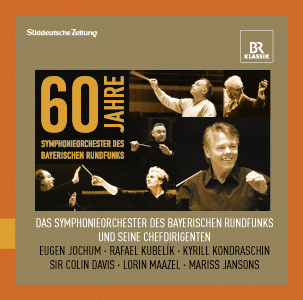 For orchestras, the in-house label is the season’s must-have accessory. The latest orchestra to set one up is the Bavarian Radio Symphony Orchestra. BR-Klassik launched last month on the orchestra’s 60th anniversary and one of its first offerings is an anniversary six-CD box set, each disc featuring notable performances by the orchestra’s six chief conductors: Eugen Jochum, Rafael Kubelík, Kyrill Kondrashin, Colin Davis, Lorin Maazel and Mariss Jansons.
For orchestras, the in-house label is the season’s must-have accessory. The latest orchestra to set one up is the Bavarian Radio Symphony Orchestra. BR-Klassik launched last month on the orchestra’s 60th anniversary and one of its first offerings is an anniversary six-CD box set, each disc featuring notable performances by the orchestra’s six chief conductors: Eugen Jochum, Rafael Kubelík, Kyrill Kondrashin, Colin Davis, Lorin Maazel and Mariss Jansons.
The orchestral vaults, obviously flush with rare gems as befits a radio orchestra of this calibre, are going to be a highlight of this particular orchestral recording venture. And this first contribution is a fascinating peek into the stash – though not always for the right reasons.
So here’s what you get: a live recording of Jochum conducting Wilhelm Furtwängler’s Second Symphony, a Bruckner Eight from Kubelík, Kondrashin’s Franck and Rimsky-Korsakov, Davis’s Elgar and Vaughan Williams, Maazel’s Stravinsky, and Strauss from Jansons. It’s a ragtag bunch with great highs and great lows.
The lows, not surprisingly, follow the real lows the orchestra experienced in the 1980s and 1990s under Colin Davis and Lorin Maazel. Colin Davis’s Enigma Variations begin in the soggiest of bogs. The beat is ambiguous, the feel soft-focused. We are meant to be feeling our way, maybe, but not losing our way, surely? Things sharpen up, burst out radiantly, come together when necessary, but not often enough. His performance of Vaughan Williams’s Sixth is more robust, though it falls short of being truly moving.
The shortcomings of Maazel’s Rite of Spring, on the other hand, are strangely wonderful. The performance seems to offer a solution to Stephen Walsh’s conundrum on the genesis of The Rite of Spring. In his biography of Stravinsky, Walsh can’t understand how Stravinsky comes to start to compose The Rite after Firebird but before Petrushka. The Firebird and Petrushka are recognisably from the soundworld of Rimsky-Korsakov, he contends, while The Rite is from somewhere else completely. Not when Maazel is conducting. The 19th century of Rimsky-Korsakov and Tchaikovsky, their lyricism and buoyancy, is all you can hear in Maazel’s rendition. It’s remarkable; Maazel successfully untangles every single Stravinskyan knot, beautifies every bit of primitivism, lightens every corner of darkness. The result: a ballet.
The Kondrashin is a real find – one of the only concerts he performed with the orchestra before he died in 1981 before being able to take up his contracted post. The Franck Symphony in D minor has a real fire in its belly: it courses along with agogic conviction, sweeping its harmonic and melodic ideas up and out of the work with a distinctly Russian fury.
The Jochum disc is intriguing only for its historical context. It was the closest Furtwängler ever got to conduct the orchestra, having consistently refused to do so in order not to offend the neighbouring Munich Philharmonic. When Jochum asked Furtwängler if he would conduct his Second Symphony – which Furtwängler cared more about than any of his achievements as a conductor – he agreed to lend a guiding hand. A few days before the performance, he died, and the concert became an emotional musical eulogy. But this is really where the interest ends. Musically, it is a baffling work: interminably long, confusing, busy, resembling an overstuffed Bruckner symphony.
And so to the real joys of the set: the Jansons and Kubelík performances. Jansons’s Strauss (Till Eulenspiegel and the Rosenkavalier Suite) is tender, supple and soft – qualities often missing from the orchestra's earlier partnerships. Anja Harteros has a depth and warmth to her voice that suit the Four Last Songs wonderfully and, when necessary, there’s spectacular latent power in reserve too.
Worth the price of the set alone, however, is the Kubelík Bruckner Eight. He has quite a different, much more organic and fluid conception of this symphony than some, and drives speeds fast at times, which means the symphony can sit very comfortably on one CD. There is a wild ferocity to the first movement that is almost irresponsible. In the scherzo the timpani play a neat, cheeky, frightening role. And the slow movement becomes a passionate, pullulating love song.
I’ve never heard such a burnished opening theme to the slow movement, almost consumed by the heat coming off the vibrato. Nor have I ever thought that this movement could work in this unabashed romantic way. I’ve always presumed that presenting the movement with such ardour so early on would render the climaxes de trop. I’ve always thought that there needs to be an awkwardness, a hesitancy and coldness to some of the musical material in order for there to be some balance in this work. But, actually, when the music is as teeming with life as it is in this performance de trop-ness never once comes into it.
Ferocity of another order opens the final movement, the surly, bullying trombones lunging at the listener from the saddles of the galloping strings. The thrill continues right to the end, whereupon Kubelík's first and only serious lapse of judgement occurs: the tempi don’t flinch, and the peal of brass whisk you through to the end before you’ve been able to catch your breath. Which, thinking about it, could be Kubelík's point. Exclusively available at the BR-Shop

Add comment